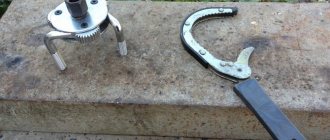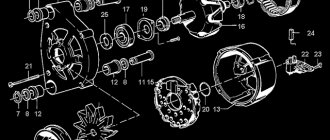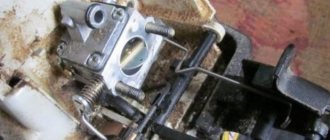| № | Name | Rating | Nomination |
| 1 | Airline AK-F-03 | 4.80 | Best price |
| 2 | JTC AUTO TOOLS 1942 | 4.76 | The most compact tool |
| 3 | AvtoDelo 40504 | 4.72 | The most popular |
| 4 | JONNESWAY AI050043 | 4.70 | Long warranty period |
| 5 | Delo Techniki 800410 | 4.68 | Large operating range |
| 6 | SUPER-EGO 107120000 | 4.65 | The highest quality tool |
| 7 | JTC AUTO TOOLS 4667 | 4.62 | The best choice for Toyota cars |
| 8 | JONNESWAY AI050009A | 4.60 | Ease of use |
| 9 | Ombra A90020 | 4.57 | The most durable puller |
| 10 | ROCKFORCE RF-61904 | 4.50 | The optimum ratio of price and quality |
Difficulties in unscrewing the oil filter are usually associated with the operating conditions of this element. Elevated temperatures and constant interaction with the external environment often lead to elementary sticking of the filter to the supporting surface. Do not forget that when choosing a place to install an oil filter, designers are not at all concerned with ease of access and maintenance. This is why on new cars the oil filter can be installed in the most unexpected place, which must be taken into account when choosing a puller. We should not forget that any maintenance, regardless of the scope of the work, necessarily includes an oil and filter change. This means that the puller is guaranteed not to lie idle.
There are several types of devices for dismantling oil filters, which differ in design, purpose and principle of operation. The most common types of pullers are:
Chain.
To grip the filter housing, a loop of chain is used, the length and thickness of which depends on the model of the tool. The diameter of the loop can be adjusted, allowing the puller to be used for different filter sizes.
Tape and belt.
The operating principle of such tools is identical to chain models. The difference is that metal or plastic tapes, as well as leather or polymer straps are used as fixing devices.
End
The tool is made in the form of a cup with a hole for a socket wrench with an external connecting square. The advantage of such devices is reliable fixation and uniform distribution of forces.
Sickle-shaped and tick-borne.
Such models are distinguished by their simplicity of design, ease of use, and the ability to adjust the working width. On the other hand, given their size, sickle and tick models are poorly suited for working in confined spaces.
Universal.
Due to their specific gripping technique, such devices are called “crabs.” The design includes two or three grippers with a flat or round working surface. The fixing devices are connected to the connecting square via a gear drive.
Top 10. ROCKFORCE RF-61904
Rating (2021): 4.50
Optimal price-quality ratio The best choice for self-service of the car - for a reasonable price you get a high-quality tool at your disposal.
- Characteristics
Average price: 867 rubles
- Country: Taiwan
- Type: crab
- Working width: 65-110 mm
- Weight: 650 g
A universal oil filter puller that is ideal for working in confined spaces. The model is made of metal coated with a protective anti-corrosion compound. Three paws with a corrugated coating are used as a gripping device, which firmly bite into the body. When dismantling oil filters, this property does not play a special role. However, if you need to tighten the new filter a little, it will be almost impossible to do without dents on the housing. There are also questions regarding the quality of the welded joint of the gripping devices. It is clear that the model does not belong to the category of a professional tool, but the seam could clearly be neater.
Advantages and disadvantages
- Anti-corrosion coating
- Corrugated surface of the paws
- Adjustable working width
- Weld joint quality
See also:
- 15 Best Oil Filter Manufacturers
Homemade puller
After familiarizing yourself with the industrial versions of the special tool, it is easier to understand how to make an oil filter puller on your own. To do this, you need to choose a simple device design and copy it for personal use. The main nuances are:
- Making Crab and Cup parts at home will be more expensive than buying a tool in a store;
- Usually scrap materials, waste from cutting rolled metal, fasteners, used tow rope tape and consumable belts are used;
- the device should be easy to use, then you can unscrew the filter quickly;
- there is no need to copy the entire linear series, because a specific internal combustion engine uses one filter size.
The most popular homemade options are discussed below.
Chain
To build a chain oil filter puller on your own, you will need the following materials:
- a piece of double-row chain, for example, a bicycle chain, slightly longer than the diameter of the filter (2 - 4 plus links);
- hexagon 5 - 7 cm long of any size for a standard key.
The chain can be welded to the hexagon or first rivet it into a loop, weld a piece of rolled metal from the inside anywhere. The work will take 15 - 30 minutes, you will need a hammer and a welding machine.
Chain and hex tool
In the absence of a piece of rolled metal, you can take an adapter shank for a cone drill. In this case, you will have to turn the top part turnkey.
Homemade chain tool
A piece of tube flattened at one end will eliminate the need for welding. To do this, insert the edges of the chain into the flattened end of the tube, drill a hole to fix it inside, for example, with a nail or screw through.
Chain attachment with tubular handle
Belt
If you use a belt loop, you can pull out the oil filter yourself even faster:
- a piece of belt, preferably with transverse slots, wraps around the filter with the smooth side;
- the ends are passed through the hole of a spanner wrench of a suitable size;
- When rotating, the belt splines prevent it from slipping into the key eye.
Homemade belt wrench
The material has sufficient roughness and elasticity to transmit torque without tearing or twisting.
If you make a slot in the socket head and place a similar piece of belt in it, you will get a more convenient device for working in confined spaces.
Belt key from head
Tape
In the garage, unscrewing the oil filter consumable element can be done with a piece of used tow rope made of nylon tape. In principle, the handles of bags and backpacks are suitable, which allows you to avoid investing additional funds in repairs.
The characteristics of the tape are slightly inferior to the belts, but they have a similar shape, so it is logical that all keys are made using the same technologies. The most popular end puller is:
- a groove is cut in the hexagon, bolt, socket head;
- 2 through holes are drilled for screws;
- The edges of the tape are laid and fixed with screws or rivets.
Homemade band wrench
The adapter for a cone drill already has a groove, but in hardened metal it is difficult to drill holes for fixing the belt with screws, so you can sew a ring from this material, pass one edge through the hole, and insert an improvised fastener made of a nail or wire on the other side.
This will not change the principle of operation of the key; it’s just that at the moment of selecting free play, this locking element must be held until the tape is fully tensioned.
Clamping
This homemade device is copied from the Cup. However, at home it is difficult to make slots on the inside of the pipe, so the tool is secured to the filter body with a clamping screw. The top arcuate plate is welded to the tubular spool to secure the hex socket/wrench nut.
Homemade clamp puller
Due to the simple design of the key, a drawing is not required; it is enough to cut a piece of pipe with an internal diameter slightly larger than the filter, about 5 cm long. If the nut is located at the top, you can use a homemade puller, even in a confined space.
Top 9. Ombra A90020
Rating (2021): 4.57
The most durable puller No welds, screws or rivets ensure a strong design and long service life.
- Characteristics
Average price: 648 rubles
- Country: Taiwan
- Type: end
- Working width: 68 mm
- Weight: 168 g
A high-quality puller for oil filters, which compares favorably with similar products due to its structural integrity. The tool is made in the form of a cup with a diameter of 68 mm - this size is most often found in engines of Korean and Japanese cars - Toyota, Honda, Kia and Hyundai. To use the puller, you will need a 3/8″ square wrench. Powder coating reliably protects the metal from corrosion and withstands various external influences quite well. The disadvantage of the tool can be considered only a limited scope of application. For those who purchase a puller for personal use, the problem loses its relevance.
Advantages and disadvantages
- Structural Integrity
- Protective covering
- Ease of use
- Limited scope
Pincer-shaped and sickle-shaped pullers
Both have 2 working tubes with a curved design and anti-slip notches, as well as one or even two handles. The small grip of such pullers is compensated by simple controls. The filter is clamped with it like pliers, so there is little complexity here.
As you can see for yourself, there is something to unscrew the oil filter, but is even the cheapest puller worth the money? Any responsible driver will think a hundred times before making such a purchase, especially since there is a worthy alternative - a homemade tool.
The simplest thing: take a regular worn belt from the generator and a screwdriver. We twisted the filter with it, inserted a screwdriver into the hole and voila. But, if you want something similar from what I described, I offer you an educational video where you will learn how to make a puller with your own hands from an ordinary bicycle chain. Cheap and cheerful, and most importantly – effective!
And one more thing, if your engine has not seen a rag for a very long time, and to get to the filter you need to overcome more than one layer of dirt, on this page you will learn how to wash the engine quickly and effectively. I have nothing more to add, see you soon!
- Self-replacement of the air filter for Skoda Octavia A5
- Fuel filter for Toyota RAV 4 3 4th generation
- Oil change Toyota Yaris Photo instructions on how to change the oil and oil filter on Yaris 3
- Changing oil and fluid in the automatic transmission of Toyota Corolla Fielder
Top 8. JONNESWAY AI050009A
Rating (2021): 4.60
Ease of use To work with this tool, no special skills are required - just throw the tape over the filter housing and select the required degree of tightening using a screw mechanism.
- Characteristics
Average price: 640 rubles
- Country: Taiwan
- Type: tape
- Working width: 112-145 mm
- Weight: 370 g
Belt puller for oil filters for professional use, recommended for use in automotive workshops. Despite its unassuming appearance, the tool does its job perfectly. The steel tape has special notches that increase the strength of the filter fixation. The reliable screw mechanism allows you to quickly select the diameter and the required force. Some inconvenience is caused only by the handle, which must be pressed against with an open palm. It turns out that if the length of the tool is sufficiently long, the design does not provide for a normal grip of the tool.
Advantages and disadvantages
- Steel tape
- Convenient adjustment mechanism
- Professional tool
- Inconvenient handle
The only narrow profile puller - cup
The tool, which evokes associations with an ordinary kitchen cup, is made for a specific type of oil filter. Hence, the likelihood of making a mistake when purchasing increases significantly.
Thanks to its design features with a cup, you can easily unscrew the cleaner even from the most inconvenient position. It is placed on the ribbed filter housing; note: the edges located in the inner circumference of the key must coincide with the filter ribs.
If you are interested in such a creation, in the wide range of the modern car market, you will no doubt be able to find a cup for your car. Moreover, for those who have started a car repair business, you can order a set of pullers of this type, and you can do everything without leaving your home!
Next, let’s briefly look at each of the seven universal pullers and make sure whether they really are what they are advertised to be.
DETAILS: How the driveshaft works. DIY replacement
Top 7. JTC AUTO TOOLS 4667
Rating (2021): 4.62
The best choice for Toyota cars The design of the puller is specially designed taking into account the location of oil filters in Toyota and Lexus cars.
- Characteristics
Average price: 900 rubles
- Country: Taiwan
- Type: end
- Working width: 72.5 mm
- Weight: 186 g
An extremely simple and reliable oil filter puller designed for servicing Toyota and Lexus cars. There is simply nothing to break here - the tool itself is a bowl with a multifaceted working surface that completely follows the contours of the outer surface of the filter housings. The design allows you to work in hard-to-reach places when the oil filter is located in close proximity to attachments. The model is designed for use with a ½″ square wrench or a 21 mm wrench. The only disadvantage of the model is its limited scope of application, since filters of these standard sizes are installed exclusively on Japanese cars.
Advantages and disadvantages
- Design reliability
- Compatible with Japanese cars
- Ability to work in hard-to-reach places
- Limited scope
See also:
- 5 best oil filters for Lada Vesta
Belt and chain pullers
You will need the following tools to make your own chain puller:
- threaded water pipe;
- stub;
- old bicycle chain.
So, let's begin the actual manufacturing process. This process is labor-intensive, requiring some knowledge and skills, but it can be done fairly quickly, and most importantly, it is effective.
- Take the plug and drill a hole with a diameter of 9mm.
- Now we need to make this hole square. This is done using a file (the size should be equal to the end of the ratchet wrench).
- Screw the plug onto the end of the pipe. Secure it by welding.
- Next, we mark the part and drill holes through which the chain will pass (you can use 2 or even 3 chains).
- Try on the sizes of chains for the most commonly used filters so that the puller is almost universal (it is necessary to try on so that when free, the chain can easily be put on the filter).
- Now we take the chain, squeeze out the pins (for extrusion, you can use any tools that you find at hand).
- Shorten the length of the chain and insert the pins back.
Done, the chain device has been successfully made with your own hands. This thing will always come in handy and can easily cope with the difficulties of removing the oil filter. Immediately put it in your car enthusiast's kit and always keep it at hand.
By choosing the chain option, you can unscrew any filter with a diameter from 60 to 140 mm. By and large, this is an ordinary single-row or double-row chain attached to the handle. Despite the larger gripping range than the crab, the chain puller is universal, but somewhat relative. It's all about the handle; due to its size, it is impossible to use this tool in some cars.
In order to unscrew the filter with such a device, you need to wind the chain around the body of the purifier, hooking the end to a special hook located on the handle. Then everything is simple, you rest the puller against the filter and pull the handle, which acts as a lever.
If the puller you purchase already has a ready-made loop, it is even easier to use. Having thrown the chain over the cleaner, you also need to pull its edge, which comes out of the groove at the end of the handle, at the same time press in the desired direction and unscrew the unusable element.
DETAILS: How to replace the fuel filter on a Chevrolet Niva
The belt version has an average girth range of about 25-160 mm, and is similar to the chain version, but there are exceptions. Thus, a belt forming a loop can have one free end or both its sides are secured with a metal rod.
To dismantle the oil filter using it, you need to wrap the cleaner around the belt with a belt and wrap the remaining part of it around a rod. Having screwed it in this way until it stops, the filter is unscrewed using a suitable wrench, which is thrown onto the square rod structure.
The most affordable design for self-production is a belt puller. This could be an old leather trouser belt, or a rivulet from an engine attachment. Most likely, you will not need a universal tool, so we draw a drawing after measuring the diameter of the oil filter.
Handle - lever is made of hard wood, textolite or metal. The main thing is to correctly calculate the thrust surface. The lever should tighten the belt and serve as support when turning the filter.
An even simpler option is made from a wide leather belt. A longitudinal cut is made in the middle. The belt is folded in half around a pin - a rod with a diameter of 6-10 mm.
The belt is wrapped around the filter, and a lever is inserted into the notch: a powerful screwdriver or a pry bar. By applying force to the lever in the direction of rotation, you simultaneously tighten the belt. You can make a simple belt puller yourself from nylon keeper tape (or parachute line).
We take a square corrugated pipe and cut a groove for the tape at one end. We insert the tape and fix it with a steel ring (saw off a piece of a round pipe). If the corrugated pipe is grabbed with a wrench, the puller is ready. You can weld a socket head with a square at the end under the handle with a ratchet.
Throwing a loop around the filter housing, twist the corrugated pipe until the tape is tightened. The puller fits any filter diameter. A similar design is obtained from an old timing belt. It must be secured with a loop in an unnecessary square head (for example, from a broken cardan key).
The only drawback is that such a puller only fits one diameter of the oil filter, but you don’t want to work at a car service center. But the timing belt has excellent friction properties: the puller will not slip and strip the oil filter housing. This is important when installing a new cartridge.
DETAILS: Review of 75W-90 gear oil Rating of the best gear oils from Motul Castrol ZIC and other manufacturers
The next most popular material for a puller is a loop made from a bicycle chain (or timing chain, depending on who you are). Such devices are produced industrially and are popular among drivers.
If you make a chain puller “according to science”, there is a standard drawing. A lever is cut out of a massive open-end wrench - a handle in the shape of an ice ax. One end of the chain is secured with a pin at the base of the lever. And the second one clings to the tooth, depending on the diameter of the filter.
The mechanism works flawlessly: the stronger the force when unscrewing, the more powerful the grip. The housing may be damaged, so a puller will not be suitable for tightening. Or you need to lay a piece of thick rags.
Making it is quite simple: take a steel hexagon and attach a chain to it in one or two rows. You can simply weld it. If you are working only with your car, you need to accurately calculate the length of the chain according to the diameter of the filter housing.
A more universal device (regarding the diameter) is made from a long spark plug head. We drill a groove and thread a double-row chain into it. After that, we simply close the links and get a ring. When tightened around the filter, the chain simply screws onto the head. Therefore, a “two-row” is needed; a thin chain will not wrap around the axis.
Instead of a spark plug head, you can use a steel hexagon (the main thing is that the size matches the key). On the one hand, grooves are cut across the axis of rotation. Then we drill holes for the studs (already along the hexagon). We insert the open chain links and hammer in the studs.
Similar samples are also available for sale. If you do the work carefully, a homemade puller is no different from an industrially manufactured one.
Top 6. SUPER-EGO 107120000
Rating (2021): 4.65
The highest quality tools The company's production facilities are located in Spain. The use of modern technological equipment guarantees high quality tools.
- Characteristics
Average price: 3223 rubles
- Country: Spain
- Type: chain
- Working width: 25-115 mm
- Weight: 1200 g
The chain puller for oil filters belongs to the category of universal tools. Due to its high grip strength, it can be used for its intended purpose, and can also be used as a pipe wrench when carrying out plumbing work. The chain is made of tempered steel, which has high elastic deformation coefficient and strength. The special shape of the teeth makes it possible to clamp and release the filter without changing the position of the key. The forged handle, which has undergone double heat treatment, deserves special mention. The special shape and stiffening ribs ensure resistance to the highest loads. You have to pay for reliability - the cost of the tool is an order of magnitude higher than its analogues.
Advantages and disadvantages
- Durable chain
- Special tooth shape
- Hardened handle
- Load resistance
- High price
Top 5. Delo Techniki 800410
Rating (2021): 4.68
Large working range Thanks to the long belt, the loop diameter is adjustable from 25 to 110 mm, which ensures the versatility of the puller.
- Characteristics
Average price: 813 rubles
- Country: Taiwan
- Type: belt
- Working width: 25-110 mm
- Weight: 380 g
A simple and reliable tool with an almost unlimited service life. The gripping device is made in the form of a strap made of polypropylene - a durable material that is resistant to stretching, as well as the effects of petroleum products and solvents. This design allows the use of a puller for dismantling various threaded connections. The Belt itself is attached to a metal handle, which plays the role of a lever and a stop. This means that for the puller to work effectively, it is necessary to provide free access to the oil filter. This is not always possible, especially on modern models from the world's leading manufacturers: Toyota, Honda, Kia, Hyundai, Renault and other companies.
Advantages and disadvantages
- Simplicity of design
- Reliable polypropylene belt
- Multifunctional tool
- Need a lot of space to work
Top 4. JONNESWAY AI050043
Rating (2021): 4.70
Long warranty period The reliability of the tool allows the manufacturer to guarantee uninterrupted operation of the puller for one year - this is the best indicator among similar devices.
- Characteristics
Average price: 1990 rubles
- Country: Taiwan
- Type: tick-borne
- Working width: 53-118 mm
- Weight: 460 g
Practical tool with adjustable working width, made of chrome vanadium steel, which ensures resistance to mechanical stress. The design of the model allows you to fix the filter using four landing planes with a toothed profile. The puller is suitable for working in difficult conditions - the surface of the tool is resistant to oil products, and for dismantling stuck filters, there is a function for adjusting the applied force, implemented using a screw mechanism. The only disadvantage of the model is its high price. On the one hand, the cost of the instrument is quite justified, but for a home instrument it is still a bit expensive.
Advantages and disadvantages
- Chrome vanadium steel body
- Robust design
- Adjustment of fixation force
- High price
See also:
- 5 best oil filters for Kia Rio
Crab
A truly universal option with which you can unscrew any oil filter. Its design is simple: 3 adjustable gripper arms, fixed between each other by two plates; on the back side there is a tip for a spanner wrench or a hole for a socket wrench.
There are models of completely different dimensions, but generally the average grip values vary between 60-125 mm. Anyone can use a crab, the main thing is to adjust the paws and the job is practically done. This is one of many tools that can perform its functions in a very narrow space. Moreover, the harder you press on the lever, the tighter the crab will squeeze the purifier in its arms.
Top 3. AvtoDelo 40504
Rating (2021): 4.72
The most popular Affordable cost and ease of use make this puller the most popular tool.
- Characteristics
Average price: 350 rubles
- Country: China
- Type: crescent
- Working width: 65-110 mm
- Weight: 240 g
An easy-to-use tool, the working part of which is made in the form of a toothed, curved metal plate with a movable lip. This element is responsible for the reliable grip of the filter housing. For comfortable work there is a comfortable plastic handle. Thanks to the long length, the leverage of force is significantly increased, eliminating the need for rough physical impact. Please note that this model is not designed for difficult operating conditions. If you plan to regularly tear off massive stuck-on oil filters, it is better to look at another model. When performing work, you need to ensure cleanliness - if oil gets in, the handle becomes very slippery.
Advantages and disadvantages
- Low price
- Ease of use
- Big lever
- Adjustable working width
- Slippery handle
- For personal use only
How did you experience it?
We tested each tool for the maximum torque that it is capable of transmitting to a cylindrical steel blank simulating an oil filter. If it can “grab” a smooth surface, it can easily grab onto a real filter. Only the polyhedral puller escaped these tests, which, even if it wanted to, would not be able to unscrew the cylinder.
We also assessed the mechanical strength of the pullers, manufacturing standards, and ease of use—the final rating was given on a five-point scale.
Of all the tested pullers, we will single out one best representative from different groups.
Top 2. JTC AUTO TOOLS 1942
Rating (2021): 4.76
The most compact tool The small size and shortened gripping devices make the purchase of this puller the best solution for working in hard-to-reach places.
- Characteristics
Average price: 1010 rubles
- Country: Taiwan
- Type: crab
- Working width: 63-102 mm
- Weight: 430 g
A universal tool with a large working range. High quality workmanship allows the model to be used for independent and professional car servicing. The gripping devices are three paws with a flat working surface, which provide strong and neat fixation of the filter. A special coating protects the metal surface from corrosion, which saves the owner from problems with finding storage space. To work with the tool, you will need a 1/2″ square wrench or a 21 mm open-end wrench. It is worth noting that the mounting hole for the square does not correspond to the declared dimensions - there is a slight play. It does not affect performance, but can irritate overly demanding professionals.
Advantages and disadvantages
- Compact dimensions
- Workmanship
- Protective covering
- Inappropriate square size
Oil filter puller sets
As a rule, the kits include several universal pullers. As well as a set of inserts for unscrewing drain plugs. A knob and magnet may be present. The storage system is a tray or a durable plastic portable case. There are also sets of “cups” for most popular car models, which makes such sets universal.
The kits are used in vehicle service centers or small auto repair shops. If the puller from the set is worn out or damaged, it can be purchased separately. The design of the bowl-type puller allows you to unscrew and tighten the filter, observing the technical requirements of car manufacturers using a torque wrench.











